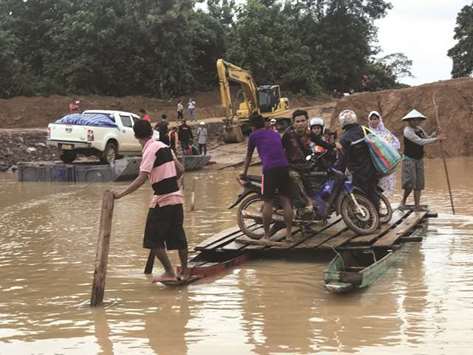The Laotian prime minister said yesterday 131 people are still missing two days after a dam collapse swamped several villages in the country’s south, killing at least 26 people.
In a rare televised press conference by the leader of the secretive communist country, Thongloun Sisoulith gave the most specific figure so far for the number unaccounted for.
Earlier official reports spoke of hundreds missing in Attapeu province.
“One hundred and thirty one people have been reported missing,” he said, adding all of them were Lao nationals.
Survivors have questioned why they got little warning of the deluge, which inundated several villages across a vast area with several metres of flood water.
Two South Korean contractors said they had reported damage a day before parts of the Xe-Namnoy dam gave way on Monday and unleashed a wall of water.
Thai consular official Chana Miencharoen, at the scene of the relief effort, said that by late afternoon yesterday 26 bodies had been recovered.
“Seventeen others are injured and in hospital,” he said, adding roof-level floodwater was hampering rescue efforts in a remote area of the poor and landlocked Southeast Asian country.
Information trickled slowly out of Laos as the publicity-shy country tried to get to grips with the disaster.
The Vientiane Times reported that 3,000 were in need of rescue as yesterday afternoon, taking shelter in trees and on rooftops.
Footage on Laos television showed people huddled on roofs awaiting rescue as muddy water swirled menacingly just below them, with the army and local volunteers leading the rescue effort.
Questions began to emerge over the collapse, with some of the displaced saying they were warned to leave their homes only hours before disaster struck.
“It happened quickly, we had little time to prepare ourselves,” Joo Hinla, 68, from one of the worst-hit villages of Ban Hin Lath, said from a warehouse crammed with over 700 displaced people in a neighbouring province.
“All of the houses in my village are under water. Four of my family are missing, we don’t know about their fate yet.”
Hundreds of other displaced people, including women, children and the elderly, sat on the floor nearby surrounded by plastic bags crammed with meagre belongings.
Laos, poor but blessed with abundant natural resources, aims to become the “Battery of Asia” allowing dozens of foreign-funded dam projects across its network of rivers.
But fears over the environmental impact of the projects, which export most of their electricity to neighbouring Thailand and China, go virtually unvoiced inside the tightly controlled country.
Villagers across the country have been moved, some several times, to make way for dams whose benefits are mainly enjoyed outside of the country, campaigners say.
Once complete, around 90% of the electricity generated by the Xe-Namnoy dam was destined for Thailand.
The remote flooded area is only accessible by helicopter and flat-bottomed boats, with roads badly damaged or completely washed away.
South Korea was sending a relief team to the area, President Moon Jae-in’s spokesman said in Seoul.
“Our government must actively take part in on-site relief efforts without delay as our companies were involved in the construction of the dam,” Moon was quoted as saying.
Two South Korean companies involved in the $1.2bn project said damage was reported a day before the dam collapsed following heavy monsoon rain.
SK Engineering & Construction said it discovered that the upper part of the structure had washed away at around 9pm on Sunday.
“We immediately alerted the authorities and began evacuating villagers downstream,” it said in a statement.

People use a makeshift ferry to cross the swollen Xe Khong river due to flash flooding in Sanamxai, Attapeu province, yesterday.


